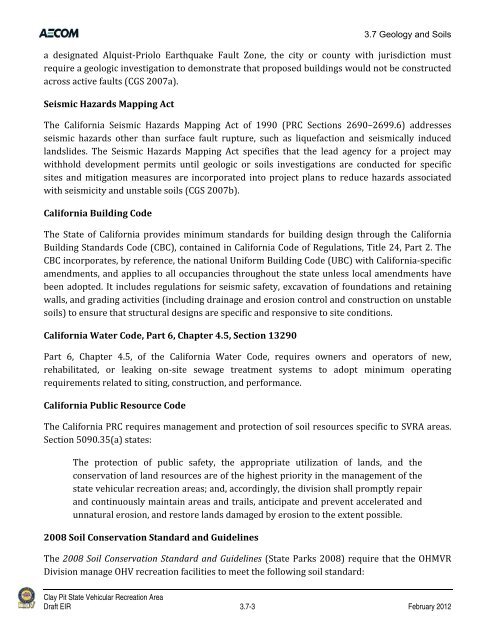Draft Environmental Impact Report - California Off Highway Vehicle ...
Draft Environmental Impact Report - California Off Highway Vehicle ...
Draft Environmental Impact Report - California Off Highway Vehicle ...
Create successful ePaper yourself
Turn your PDF publications into a flip-book with our unique Google optimized e-Paper software.
3.7 Geology and Soils<br />
a designated Alquist‐Priolo Earthquake Fault Zone, the city or county with jurisdiction must<br />
require a geologic investigation to demonstrate that proposed buildings would not be constructed<br />
across active faults (CGS 2007a).<br />
Seismic Hazards Mapping Act<br />
The <strong>California</strong> Seismic Hazards Mapping Act of 1990 (PRC Sections 2690–2699.6) addresses<br />
seismic hazards other than surface fault rupture, such as liquefaction and seismically induced<br />
landslides. The Seismic Hazards Mapping Act specifies that the lead agency for a project may<br />
withhold development permits until geologic or soils investigations are conducted for specific<br />
sites and mitigation measures are incorporated into project plans to reduce hazards associated<br />
with seismicity and unstable soils (CGS 2007b).<br />
<strong>California</strong> Building Code<br />
The State of <strong>California</strong> provides minimum standards for building design through the <strong>California</strong><br />
Building Standards Code (CBC), contained in <strong>California</strong> Code of Regulations, Title 24, Part 2. The<br />
CBC incorporates, by reference, the national Uniform Building Code (UBC) with <strong>California</strong>‐specific<br />
amendments, and applies to all occupancies throughout the state unless local amendments have<br />
been adopted. It includes regulations for seismic safety, excavation of foundations and retaining<br />
walls, and grading activities (including drainage and erosion control and construction on unstable<br />
soils) to ensure that structural designs are specific and responsive to site conditions.<br />
<strong>California</strong> Water Code, Part 6, Chapter 4.5, Section 13290<br />
Part 6, Chapter 4.5, of the <strong>California</strong> Water Code, requires owners and operators of new,<br />
rehabilitated, or leaking on‐site sewage treatment systems to adopt minimum operating<br />
requirements related to siting, construction, and performance.<br />
<strong>California</strong> Public Resource Code<br />
The <strong>California</strong> PRC requires management and protection of soil resources specific to SVRA areas.<br />
Section 5090.35(a) states:<br />
The protection of public safety, the appropriate utilization of lands, and the<br />
conservation of land resources are of the highest priority in the management of the<br />
state vehicular recreation areas; and, accordingly, the division shall promptly repair<br />
and continuously maintain areas and trails, anticipate and prevent accelerated and<br />
unnatural erosion, and restore lands damaged by erosion to the extent possible.<br />
2008 Soil Conservation Standard and Guidelines<br />
The 2008 Soil Conservation Standard and Guidelines (State Parks 2008) require that the OHMVR<br />
Division manage OHV recreation facilities to meet the following soil standard:<br />
Clay Pit State Vehicular Recreation Area<br />
<strong>Draft</strong> EIR 3.7-3 February 2012








